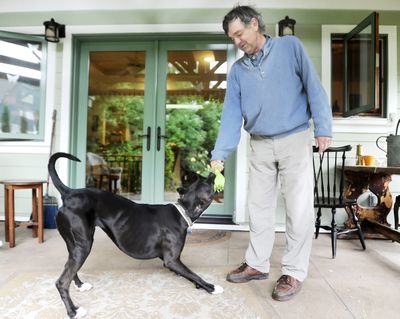Kibble doesn’t cut it for some pooch owners

ASHLAND, Ore. – At the Ashland Market of Choice where Kate Fuller shops, she could buy a pound of Angus tri-tip steak, extra-large prawns or Oregon-raised lamb for the same price she pays for dog food. Three pounds of the raw beef, chicken or bison pet patties costs up to $22, but money doesn’t matter when it means making her boxer-lab healthy and happy.
Fuller is in a minority of pet owners – about 2 percent in the U.S., said raw diet advocate and author Phil Klein – who buys natural, organic or what is called “super premium” food for four-legged family members.
Some owners buy the pet food because it is made by small-scale producers from locally raised ingredients. They see it as an extension of their locavore commitment, and Echo Fields, the sociology program coordinator and associate professor at Southern Oregon University, understands this.
Fields researches the growing importance of pets in our lives.
“We come to believe that our pets – particularly dogs – are self-aware and conscious beings, with thoughts, feelings and souls of their own,” she said. “We have ‘humanized’ our pets.”
Other owners buy natural pet food because they stopped trusting big brands when thousands of cats and dogs died of kidney failure before pet food made with contaminated gluten and rice protein from China was recalled five years ago.
And still other owners are trying to solve their pets’ itchy skin, ear problems and recurring infections and allergies. After finding no relief from conventional medicine, they turn – with or without their vet’s consent – to nonprocessed food, either made fresh at home or purchased at stores.
“Holistic vets strive to offer food that is as close as possible to what animals eat in nature,” said veterinarian Anette Heaslet, who has a traditional and holistic practice at the Cheerful Vet in Ashland.
Although she does not recommend raw diets to animals with suppressed immune systems, she said most medical conditions will improve with good nutrition.
A sick puppy was the reason Fuller started to buy raw pet food. She and her husband, Harry, rescued a 10-month-old boxador from the Phoenix animal shelter. Nora was extremely thin: 11 pounds underweight. Her coat was tinged brown from malnutrition, and she had chronic diarrhea and occasional vomiting.
The Ashland couple adopted her in 2011 and brought her to their home near Lithia Park where they believed they could treat her with love and medical attention.
“The pound is hard on dogs, harder on some more than others,” Kate Fuller said. “We needed to stop the digestive problems and put weight on her.”
The Fullers – longtime dog owners who both grew up on farms – spent hundreds of dollars on special hypoallergenic diets and diagnostic tests, but “we still didn’t know what was going on with her gut,” she said. “It was terrible to see her so thin. You could see every bone on her spine.”
They tried home remedies. They fed Nora boiled rice and chicken broth and slippery elm, which looked like unappetizing pudding. Nothing helped.
Then a professional dog trainer suggested a raw diet, and although the couple admit they were hesitant, they were also desperate. Two days later, Nora was better.
Recently, Kate Fuller was walking Nora on Pioneer Trail near Lithia Park. Nora’s coat was black and shiny. She weighed a healthy 70 pounds and was doing well in agility training.
She runs, Fuller said proudly, “like a locomotive.”
Kate Fuller said it costs $300 a month to buy Nora’s raw meat made without preservatives, artificial ingredients or cereals by Kristi’s All Natural Pet Food in Azalea.
“This isn’t about being highfalutin and spending astronomical amounts of money on our dog,” she said. “It’s about a new dietary approach to common canine maladies. Her alimentary canal only functions normally if she’s on the raw diet. It saved her.”
Kristi’s makes raw food from USDA-approved beef, grass-fed lamb, cage-free chicken and other muscle and organ meats. Mixed into the chunky pieces are peas, carrots, green beans and broccoli grown in the Willamette Valley and organic herbs from Eugene.
Although many of the products contain vitamin and mineral supplements, some experts worry that not all brands are nutritionally balanced.
Veterinarian Heaslet recommends a custom diet to her patients and equates commercial, carbohydrate-based kibble and canned food to dining only at McDonald’s.
Dogs and cats are carnivores that can digest the protein and nutrients from raw meat, she said, but get little from complex carbohydrates or meat that has lost its nutritional heft from heat.
Still, some overindulging owners do pan-sear the raw meat to entice their picky pets to eat it.